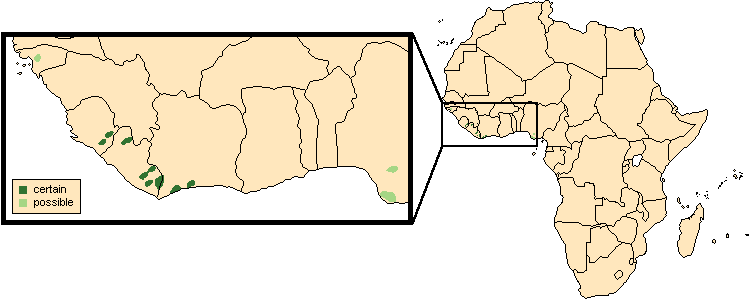![]() Return
to Artiodactyla
Return
to Artiodactyla
Classification
|
 Hexaprotodon
liberiensis
Hexaprotodon
liberiensis
Pygmy hippopotamus
![]()
Taxonomy
 |
 |
 |
Click on the pictures above for a larger view of the
photographs
|
||
General Characteristics
Body Length: 142-175 cm / 4.7-5.8 ft.
Shoulder Height: 75-100 cm / 2.5-3.3 ft.
Tail Length: 15-28 cm / 6-11.2 in.
Weight:160-272 kg / 350-600 lb.The smooth, hairless skin is black-brown to purple in colour, with the cheeks often tinted pink. A secretion of mucous keeps the hide moist and shiny. The body is barrel-shaped and is supported by proportionally long legs. The four-toed feet have virtually no webbing. The head is round and narrower than the river hippopotamus, with the eyes placed more to the sides. The stubby tail has a wiry tassel of yellow hair.
Ontogeny and Reproduction
Gestation Period: 184-204 days.
Young per Birth: 1, very rarely 2
Weaning: After 6-8 months.
Sexual Maturity: At 4-5 years.
Life span: Up to 42 years.The young are born on land or in shallow water, and nurse 2-3 times in a 24 hour period. After birth, the young lie concealed for more than three weeks.
Ecology and Behavior
Pygmy hippos have numerous resting places throughout their territory, which they use exclusively when sleeping. These resting places are usually found in moist to wet terrain. Pygmy hippos seek food on higher, drier ground, and are most active between 6 pm and midnight. Both sexes have home ranges, though those of males are much larger than those of females: a female's range covering 100-150 acres, and a male's covering about 400 acres. Despite extensive overlapping of home ranges, pygmy hippopotamuses rarely meet others of their species. Indeed, they actively avoid encounters with others, presumably through dung marking. Most movements are along 'roads' - cleared paths, canals, and tunnels - which are used by several hippos. During the breeding season, males seek out receptive females, who tolerate the males' presence when in heat. Mating takes place on land and in the water throughout a period of two days, in which 1-4 copulations may occur. When threatened, pygmy hippos usually flee: trotting into the dense jungle for a short ways, then hiding till the danger has passed. Normally silent, they have been recorded snorting, grunting, hissing, groaning, and squeaking.Family group: Solitary.
Diet: Water plants, grasses, fallen fruit, leaves.
Main Predators: Leopard.
Distribution
Rivers and swamps in dense forests in western Africa (Ivory Coast, Liberia, and Sierra Leone, and possibly Nigeria and Guinea).

Range Map (Redrawn from Eltringham, 1993)
Conservation Status
As a species, the pygmy hippopotamus is classified as vulnerable, while H. l. heslopi is considered to be a critically endangered subspecies by the IUCN (1996).
Remarks
Some zoologists replace the genus Hexaprotodon with Choeropsis. More pig-like than its larger relative, the pygmy hippo's scientific status has been quite varied - when it was first described, many dismissed it as a stunted freak, a dwarf subspecies or a juvenile specimen of the common hippopotamus. After its initial description, when no more news of the pygmy hippo reached the west, many scientists wrote it off - whatever it was - as extinct. However, its true status - as a distinct and existent species - was proven by Schomburgk in 1911, when he captured five live specimens and brought them back to Europe. The name hippopotamus is from hippos (Greek) a horse, and potamos (Greek) a river - although "river-pig" would be much more appropriate! While this ungulate is large in comparison to most others, it gets its name 'pygmy' from the fact that it is much smaller than the river hippopotamus..
Literature Cited
Boitani, L., and S. Bartoli. 1982. Simon & Schuster's Guide to Mammals. New York: Fireside/Simon & Schuster, Inc. Entry 354.Eltringham, S. K. 1993. The pygmy hippopotamus (Hexaprotodon liberiensis). In Pigs, Peccaries and Hippos: Status Survey and Action Plan. Edited by W. L. R. Oliver. Gland, Switzerland: IUCN. Available online at http://iucn.org/themes/ssc/sgs/pphsg/Contents.htm
Kingdon, J. 1997. The Kingdon Field Guide to African Mammals. Academic Press, London and New York: NaturalWorld.
Lang, E. M., K. Hentschel, and W. Bulow. 1990. Pygmy hippopotamuses (Genus Choeropsis). In Grzimek's Encyclopedia of Mammals. Edited by S. P. Parker. New York: McGraw-Hill. Volume 5, pp. 62-64.
Wilson, D. E., and D. M. Reeder [editors]. 1993. Mammal Species of the World (Second Edition). Washington: Smithsonian Institution Press. Available online at http://nmnhwww.si.edu/msw/
Return to Artiodactyla

![]()
© Brent Huffman, www.ultimateungulate.com |
|
|